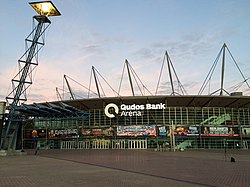 Exterior view of venue from Olympic Bvd (c. 2016) | |
 | |
| Former names | Sydney SuperDome (1999–2006) Acer Arena (2006–2011) Allphones Arena (2011–2016) |
|---|---|
| Address | Olympic Bvd and Edwin Flack Avenue Sydney Olympic Park NSW 2127 Australia |
| Location | Sydney Olympic Park (Map) |
| Coordinates | 33°51′S 151°04′E / 33.850°S 151.067°E |
| Owner | TEG Live |
| Operator | ASM Global |
| Capacity | 18,000[2] 21,032 (with floor seats) |
| Construction | |
| Broke ground | September 1997 |
| Opened | 4 October 1999 |
| Construction cost | A$200 million ($381 million in 2022 dollars[1]) |
| Architect | Philip Cox and Yaeger Architecture |
| Structural engineer | Taylor Thomson Whitting |
| Services engineer | Norman Disney & Young |
| General contractor | Obayashi Corporation |
| Main contractors | Abigroup |
| Tenants | |
| Sydney Kings (NBL) (1999–2002, 2016–present) Sydney Swifts (CBT) (2001–08) New South Wales Swifts (ANZ/NNL) (2008–2019) Giants Netball (NNL) (2017–2019) | |
| Website | |
| Venue Website | |
The Sydney SuperDome (currently known as the Qudos Bank Arena for sponsorship reasons) is a multipurpose arena located in Sydney Olympic Park suburb of Sydney, New South Wales, Australia. It was completed in 1999 as part of the facilities for the 2000 Summer Olympics.
The A$190‑million facility was designed by COX Architecture & Devine deFlon Yaeger, and constructed by Abigroup and Obayashi Corporation.[3] Bob Carr, premier of New South Wales, officially opened the stadium in November 1999.[3]
The development of the stadium was part of three subsites which also included a 3,400-space carpark which cost A$25 million,[3] and a plaza with external works, also costing $25 million.[3] The roof's masts reach 42 metres (138 ft) above ground level, and the stadium occupies a site of 20,000 m2 (220,000 sq ft; 4.9 acres).[3]
The venue is currently managed by AEG Ogden. For three consecutive years it was a finalist for the Billboard Touring Awards in the top venue category.[4]
The arena has a total capacity of 21,032 with a seating capacity of around 18,000 making the SuperDome the largest permanent indoor sports and entertainment venue in Australia.
- ^ AU = 1850-1901: McLean, I.W. (1999), Consumer Prices and Expenditure Patterns in Australia 1850–1914. Australian Economic History Review, 39: 1-28 (taken W6 series from Table A1, which represents the average inflation in all of Australian colonies). For later years, calculated using the pre-decimal inflation calculator provided by the Reserve Bank of Australia for each year, input: £94 8s (94.40 Australian pounds in decimal values), start year: 1901.
- ^ "Qudos Bank Arena". Austadiums. Retrieved 8 June 2023.
- ^ a b c d e "Acer Arena - History". Archived from the original on 30 December 2012. Retrieved 4 April 2011..
- ^ "Allphones Arena, Rod Laver named in top three global live venues - Live Music - the Music Network". Archived from the original on 18 April 2012. Retrieved 11 April 2012.